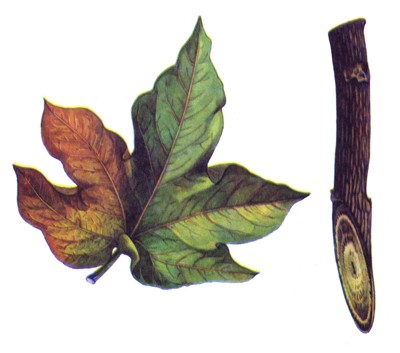Diseases
Fusarium oxysporum f. sp. vasinfectum W.C.Snyder & H.N. Hansen. - Fusarium Wilt of Cotton.
Systematic position.
Kingdom Fungi, phylum Ascomycota, class Ascomycetes, order Hypocreales, family Nectriaceae, genus Fusarium.Synonyms.
Fusarium vasinfectum G.F. Atk.;Fusarium oxysporum f.sp.vasinfectum (G.F. Atk.) W.C.Snyder & H.N. Hansen. ( http://www.SpeciesFungorum.org )Biological group.
Saprotroph.Morphology and biology.
The causative agent of Fusarium Wilt of cotton, the fungus F. oxysporum f. sp. vasinfectum has only anamorphous stage in its life cycle. Morphological structures of the pathogen are colorless or painted multicellular mycelium forming macro- and microconidia, and chlamydospores. The causative agent can affect crops such as cotton, lucerne, lupin, soybean, tobacco and weeds. A wide range of other plant species may also be infected without external symptoms. Infection sources of the fungus are chlamydospores in soil, infected cotton vegetation residues and seeds. Infection of cotton by pathogen occurs in soil through plant roots. First symptoms of the disease may appear on seedlings. In the beginning necrotic spots on cotyledons appear; later reticulate necrosis on leaves appears along their veins. Affected leaves fall, plants dry out. The affection can occur in stages of budding, flowering, and later. Developing in vascular system of cotton, the fungus causes tracheomycotic wilting, destroying the system completely. Affected tissue of conducting vessels of leaves, petioles, stalks, and bolls becomes dark brown, a characteristic symptom of the disease. On affected cotton at humidification, the fungus forms light pink mycelium with colorless multicellular curved conidia of F. oxysporum f. sp. vasinfectum. Physiological races are found in populations of F. oxysporum f. sp. vasinfectum; therefore, selection of cotton resistant to the pathogen is recommended accounting this phenomenon.Distribution.
Fusarium Wilt of cotton is registered in Central Asian countries of the former USSR; i.e., in Turkmenistan and in some places of Tajikistan and Uzbekistan.Ecology.
F. oxysporum f. sp. vasinfectum grows and develops at temperatures from 10 to 35°C. Optimum conditions are temperatures 18-27°C., soil humidity 40 to 70% and acidity of environment near pH=5.3. The pathogen affects mainly fine-fibrous varieties of cotton (Gossypium barbadense). The disease affects more intensively in places with high fraction of cotton in field crop rotations and at late replacement of susceptible varieties by resistant ones.Economic significance.
Fusarium Wilt of cotton is a harmful disease. In affected susceptible varieties yield losses exceed 45-50%. Control measures are crop rotation with sufficient fraction of cereals and unaffected crops, application of biological preparation of Trichoderma, use of resistant varieties, and chemical control.Reference citations:
Gorlenko M.V. 1968. Agricultural Phytopathology. Moscow: Visshaya shkola, 434 p. (In Russian).Goshaev D. 1970. Fusarium wilt of fine-fibrous cotton and agrotechnical measures in its control in conditions of Murgab oasis of Turkmen SSR. Abstract of PhD Thesis. Leningrad: VIZR, 17 p. (In Russian).
Dobrozrakova T.L. 1966. Agricultural Phytopathology. Leningrad: Kolos, 328 p. (In Russian).
Menlikiev M.Ya. 1973. Investigation of Fusarium wilt of fine-fibrous cotton, development and substantiation of measures, their industrial checking in Tajik SSR. Abstract of PhD Thesis. Leningrad: VIZR, 41 p. (In Russian).
Peresypkin V.F. 1987. Atlas of diseases of field cultures. Kiev: Urozhai, 144 p. (In Russian).


